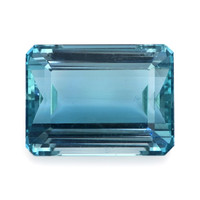Mohs Scale of Hardness of Aquamarine

The Mohs Scale of Hardness is a crucial tool in gemology, used to determine the hardness of various minerals, including aquamarine. This scale, developed by Friedrich Mohs in 1812, classifies minerals based on their ability to scratch one another. It ranges from 1, being the softest, to 10, the hardest.
Aquamarine, a stunning gemstone famed for its mesmerizing blue to blue-green hues, is a variety of the mineral beryl. It ranks at 7.5 to 8 on the Mohs scale, making it relatively hard and durable. This hardness is significant as it indicates aquamarine’s suitability for various types of jewelry, including rings and bracelets that may be exposed to daily wear and tear.
The Mohs scale helps in understanding the care required for aquamarine jewelry. Despite its hardness, aquamarine can still be prone to scratching from harder materials. It’s advisable to store aquamarine jewelry separately from harder gemstones like diamonds and sapphires to prevent scratches.
The Mohs scale also influences the cutting and shaping process of aquamarine. Due to its hardness, specialized tools are required to shape and polish this gemstone, ensuring the best display of its color and clarity.
On the Mohs Scale of Hardness, aquamarine is a relatively hard gemstone, which contributes to its durability and suitability for a variety of jewelry settings. Its ranking at 7.5 to 8 also highlights the need for careful handling and storage to maintain its beauty.
Aquamarines and their Mohs Ratings
- Hardness Rating:
- Aquamarine, a gemstone from the beryl family, typically falls between 7.5 and 8 on the Mohs scale. This ranks it among the harder gemstones, though not as hard as diamond (10), ruby, or sapphire (both 9).
- What This Means:
- This hardness level suggests that aquamarine is quite resistant to scratches from everyday encounters with materials lower on the scale, like metals or common dust (which contains quartz at a rating of 7).
Durability and Practical Implications
- Jewelry Suitability:
- Due to its hardness, aquamarine is an excellent choice for a variety of jewelry pieces, including rings, necklaces, and earrings. It can withstand daily wear well, maintaining its polish and shine.
- Care and Maintenance:
- While resistant to scratches, aquamarine is not impervious to damage. It should be protected from impacts, which could cause chipping, especially along facet edges or corners.
- Care should be taken to avoid contact with harder substances. For example, storing aquamarine away from diamonds or sapphires is advisable to prevent accidental scratches.
- Cleaning Methods:
- Aquamarine can be cleaned with lukewarm water and a mild soap. Using a soft brush, gently clean the stone, paying attention to any build-up beneath the setting. It’s generally safe to use ultrasonic cleaners, but caution is advised if the gemstone has inclusions or fractures.

The Mohs hardness rating of aquamarine at 7.5 to 8 makes it a durable and practical choice for everyday jewelry. This hardness ensures a good resistance to scratching, contributing to the gemstone’s longevity with proper care.
Regular maintenance, cautious handling, and appropriate storage are key to preserving the beauty and integrity of aquamarine jewelry. Understanding these aspects allows customers to enjoy their aquamarine pieces to the fullest, ensuring that these treasures remain in excellent condition for years to come.
Limitations of the Mohs Scale

Relative Scale, Not Proportional:
- The Mohs scale is not linear or proportional; it is ordinal. This means that the scale does not show equal increments of scratch resistance between each number. For instance, the gap in hardness between corundum (9) and diamond (10) is significantly greater than between other consecutive minerals on the scale.
Scratch Resistance, Not Overall Durability:
- The Mohs scale measures scratch resistance, not the overall durability or toughness of a mineral. Aquamarine, though relatively hard, can be prone to chipping or cracking upon impact because hardness does not equate to toughness.
Does Not Reflect Other Vulnerabilities:
- The scale does not account for other vulnerabilities like heat sensitivity, chemical reactions, or cleavage (the tendency of a crystal to break along specific planes). Aquamarine can be sensitive to harsh chemicals and extreme temperature changes, which are not indicated by its Mohs hardness.
Inadequate for Comprehensive Gemstone Assessment:
- For comprehensive gemstone assessment, factors such as clarity, color, carat, and cut are also crucial. The Mohs scale does not provide information on these aspects, which are essential for evaluating the overall quality and value of aquamarine.
Misinterpretations in Jewelry Selection:
- Consumers and jewelers might misinterpret the Mohs scale as the sole indicator of a gemstone’s suitability for certain types of jewelry. While aquamarine’s hardness makes it suitable for everyday wear, this does not mean it is impervious to all types of damage.
Limitations in Gemstone Processing:
- The processing of aquamarine, including cutting, shaping, and polishing, requires an understanding of its physical properties beyond hardness. The Mohs scale does not provide specific guidance for these processes.
Storage and Maintenance Misconceptions:
- There can be misconceptions regarding the storage and maintenance of aquamarine based solely on its Mohs rating. Even though it’s relatively scratch-resistant, aquamarine can still suffer from abrasion and wear over time, especially if stored or worn with harder materials.
While the Mohs Scale of Hardness and Aquamarine provides valuable information about scratch resistance, it’s not all-encompassing in assessing durability and quality. Understanding aquamarine’s properties beyond Mohs hardness is crucial for care, processing, and use in jewelry, ensuring a thorough appreciation of its beauty and appeal.
Please visit the link for more details about Durability and Hardness of Aquamarine!
